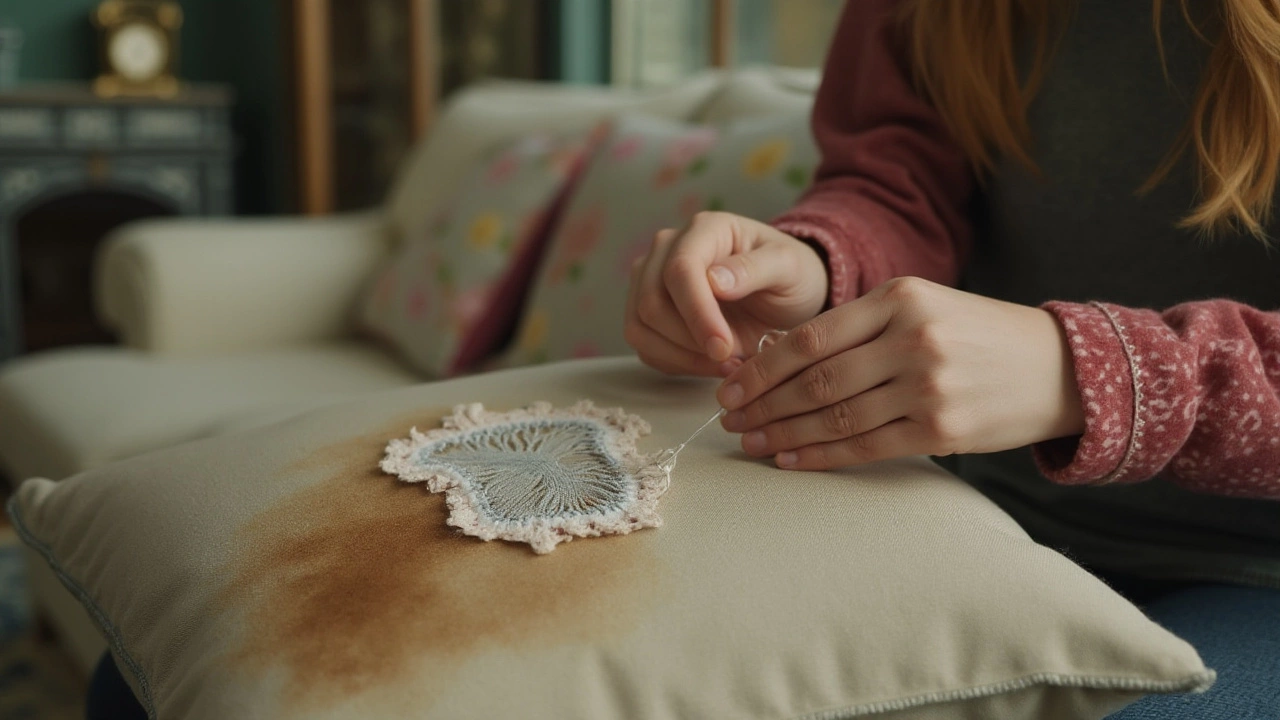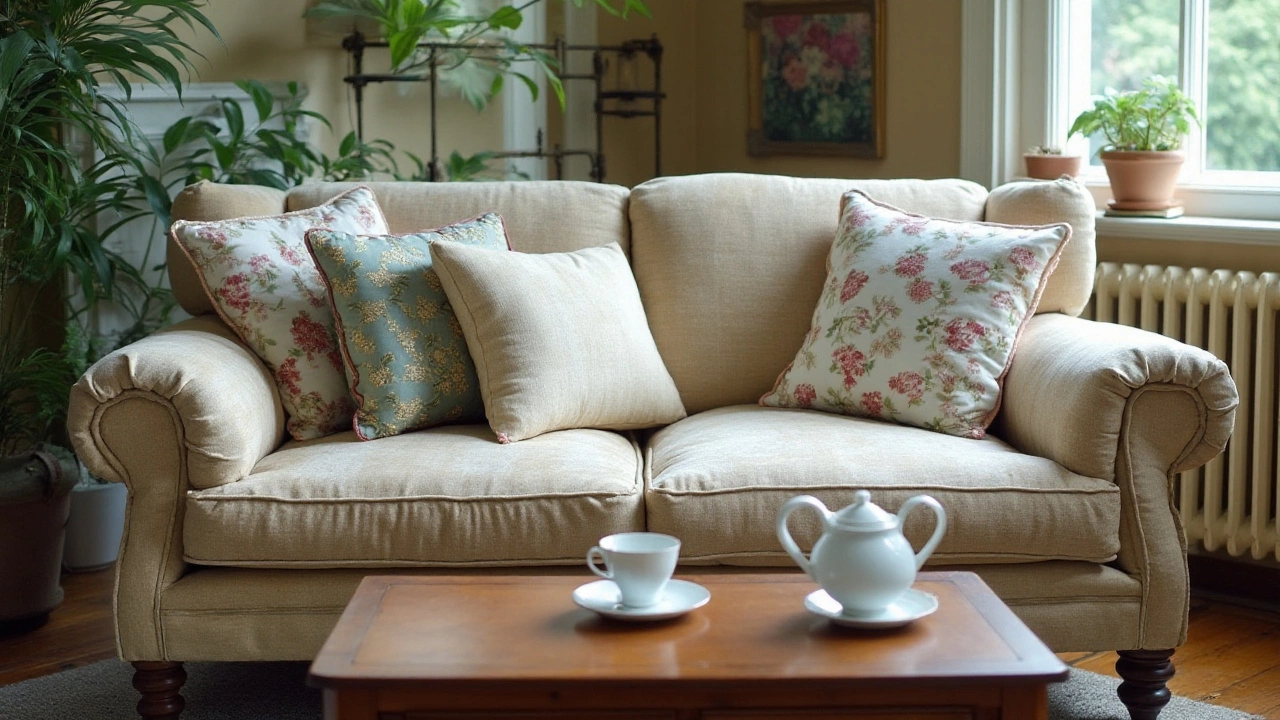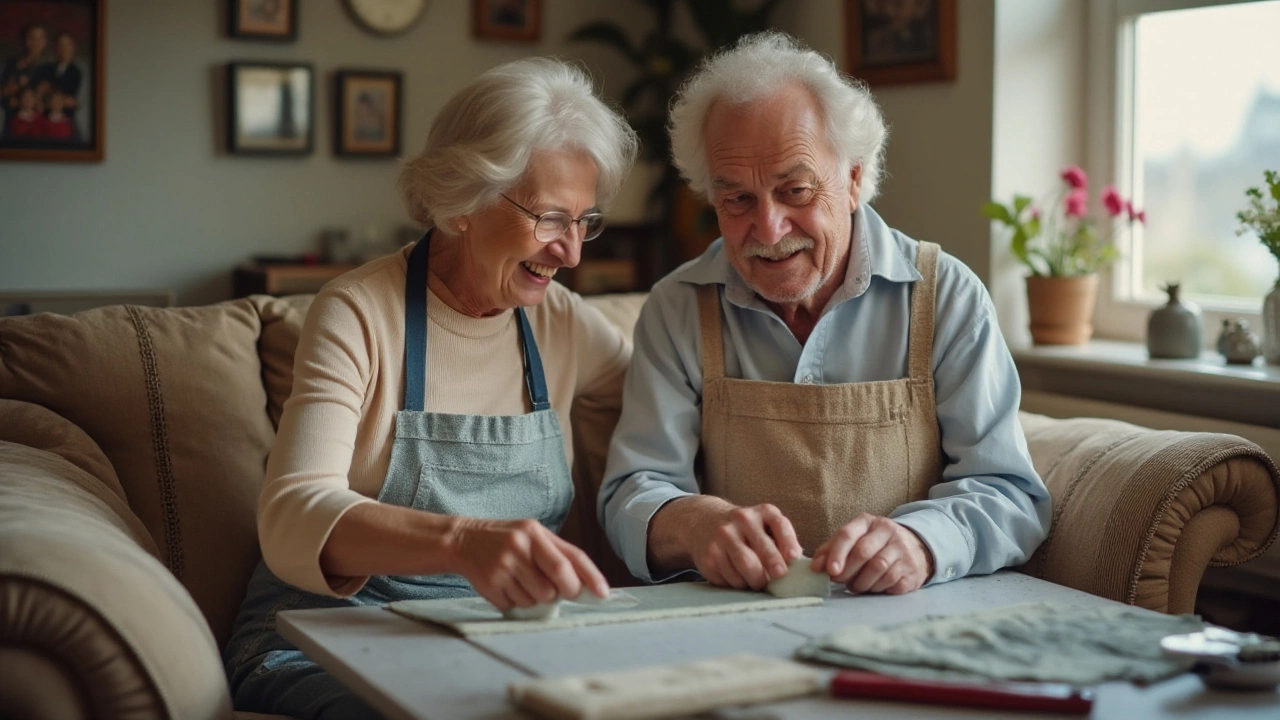Sinking into your favorite couch shouldn't feel like a journey to the floor. Yet, over time, couch cushions can lose their bounce and appeal. The good news? You don't always need to splurge on expensive replacements or brand-new furniture sets. In many cases, a few simple repairs can bring your cushions back to life.
This guide dives into the world of cushion repair, offering insights and tips to help you tackle various issues from flattened filling to worn-out covers. Whether you're battling a stubborn stain or seeking ways to bolster sagging foam, a little knowledge goes a long way in preserving your couch's comfort and style. Let's explore some practical solutions that combine DIY strategies with expert advice to rejuvenate your seating area.
- Understanding Common Cushion Problems
- Steps to Repair Couch Cushions
- When to Seek Professional Help
- Maintenance Tips to Extend Cushion Life
Understanding Common Cushion Problems
Couch cushions, often overlooked heroes of the living room, bear the brunt of our daily life. From lazy afternoons to bustling family gatherings, these plush pads endure a lot. Over time, this relentless use takes its toll, leading to some familiar and frustrating problems. Recognizing and understanding these issues is the first step towards effective repair.
One of the most prevalent issues with sofa cushions is sagging. This typically occurs when the foam or padding inside the cushion breaks down due to constant pressure. Cushions naturally lose some of their resilience with age, leaving what was once a buoyant, inviting seat feeling more like a sunken void. Another similar woe is when cushions become flattened and lumpy, markedly reducing comfort. This happens when the stuffing material becomes unevenly distributed or loses its original loft.
Next up, we have the matter of damaged upholstery. It's alarming how quickly fabric can deteriorate, especially if you have pets or in a house bustling with children. Pet claws, spilled drinks, or even just everyday friction can cause tears, stains, and fading. While this problem is more about aesthetics than comfort, torn or stained fabric can completely alter the appearance of your couch. A masterful patch or a thorough clean can do wonders for the looks of your couch.
Of course, zippers and seams also deserve a mention as they're silently crucial in keeping things together—literally. A broken zipper, loose threads, or split seams might not only look unsightly but can make removing and re-stuffing your cushions near impossible. It's not a rare sight to find a cushion cover held together by faith alone after a decade of use.
In a survey conducted by the Furniture Retailers Association, it was found that over 60% of household couches suffer visible cushion damage within the first five years.
"Most of these issues are a result of neglecting regular maintenance," says Jane Austen, a renowned upholstery expert. "Understanding these common problems and addressing them timely can significantly extend the life of your cushions."
Given these challenges, the question is, why do these problems occur, and how can they be mitigated? Often, improper care or choosing the wrong cleaning methods is a culprit behind many of these routine cushion woes. Correct techniques can mean the difference between destruction and delightful longevity. For example, regular vacuuming and using the right fabric care solutions are small but significant actions. Moreover, the environment plays a role—if a sofa is placed under direct sunlight, it may hasten fabric fading and weaken fibers. Thus, understanding your household dynamics and usage patterns can be crucial in combating these issues.
| Problem | Cause | Solution |
|---|---|---|
| Sagging | Foam breakdown | Replace foam or add padding |
| Lumps | Uneven stuffing | Re-fluff or redistribute stuffing |
| Tears and Stains | Daily wear | Patch pos or clean effectively |

Steps to Repair Couch Cushions
Dealing with shabby couch cushions doesn't have to be daunting. Whether your cushions are sagging, stained, or torn, a hands-on approach can work wonders. Let's explore some practical steps that will help restore your sofa to its prime condition. Start by assessing the extent of damage, which will guide the repair method you need. While it might seem complex, each step is straightforward and can be accomplished with minimal tools and a little patience.
1. Identify and Assess Damage
Before you dive into repairs, a comprehensive inspection is crucial. Check every aspect of your sofa: the firmness of the filling, the condition of the fabric, and the functionality of any zippers or Velcro. Often, the most common issue is compressed foam, leading to saggy seating areas. Keep an eye out for signs of wear and tear or any potential mold if moisture has been an issue. Understanding the root cause will give you a clearer picture of what’s needed in terms of materials and effort.
"A stitch in time saves nine," says upholstery expert Sarah Mitchell. "Addressing minor damages early can prevent major overhauls later on."
2. Re-fluff or Replace Filling
If you find the cushions are flat or uneven, you can often freshen them up with a good re-fluff. This might involve removing them from their covers and kneading the stuffing. For foam cushions, try wrapping them in batting to regain some volume. If the original filling doesn't improve, consider replacing it. High-density foam or synthetic fiber fill are popular choices since they provide great support and longevity. Be sure to measure your cushions before buying new filling to ensure a proper fit.
3. Repair or Replace Fabric Covers
If your cushion covers are ripped or stained, a needle and thread might be all you need to patch things up. Use matching thread to make repairs less visible. In cases where fabric is beyond repair, replacing covers with new materials can be a game-changer. Select durable fabrics that match your decor and can withstand regular use. Many upholstery stores offer ready-made covers, or you can sew your own if you have the skills. Whether prefabricated or DIY, new covers can refresh the look of your entire living space.
4. Maintain Zippers and Velcro Strips
Functional upholstery often relies on working zippers or Velcro. Examine these components for any signs of malfunction. Clean out any debris jammed in zippers and replace them if they've worn out. Velcro strips can lose grip over time but can often be revived by cleaning with a fine-tooth brush. If necessary, attach new Velcro to the covers to ensure they stay secured around the fillings.
5. Reassemble and Reassess
Once you've handled each necessary repair, it's time to put everything back together. Carefully place the fillings back in their covers, ensuring they are evenly distributed and looking plump. This final stage offers a satisfying sense of accomplishment. Take a step back and enjoy your revitalized couch. Maintaining your cushions' new condition does demand some diligence, but it also ensures your furniture remains inviting and functional.
These straightforward yet effective steps to repair sofa cushions can transform the look and comfort of your living space. By following them, you preserve both the aesthetic and practical value of your furniture, ensuring it remains a central and dignified part of your home.

When to Seek Professional Help
You've played the part of an amateur upholsterer, wielding your trusty tools with bravado, but occasionally a project may demand the expertise of a professional. Knowing when to seek professional help with your couch cushions can save you both time and possible frustration. One hallmark situation involves complex upholstery patterns. These intricate designs often require a seasoned hand to make sure everything aligns perfectly, avoiding the telltale signs of a DIY gone wrong. Additionally, if your cushions harbor an unusual odor that refuses to dissipate, it may signal a deeper issue—perhaps mildew or unseen damage inside the cushion material—that needs specialized treatment.
Your favorite sofa may also sport more than just surface level inconveniences. How do you tackle situations when the cushion fabric is stretched to its breaking point? Sometimes, wear and tear exceeds what a bit of fabric paint or patchwork can handle. Professional reupholstering offers a solution, replacing fabric wholesale rather than piecewise. In cases where heirloom furniture is involved—where the sentimental value surpasses the financial—entrusting your piece to experts ensures it receives the delicate attention it warrants.
Significant Damage Requires Expert Attention
If the cushion is decidedly flat or if the foam has begun to crumble as dust, these are tell-tale signs that a refill might not suffice. Sagging that proves resistant to fluffed feathers or stringent plumping techniques often indicates underlying issues such as broken springs or a compromised frame. Experts possess the keen eye to diagnose and address these conditions, ensuring your couch provides the comfort it should. In some instances, repairs might involve reconstructed support, like woodwork or spring replacement—tasks best left to those who can ensure the integrity and longevity of your furniture.
"Sometimes it's not worth fighting an uphill battle alone—recognize when a seasoned professional can make a world of difference," advises Claire Phillips, renowned upholsterer and interior designer.
Professionals Have Access to Specialty Materials
High-grade upholstery foam, particularly the sort that offers enhanced resilience and comfort along with specialty stitching, may not be readily available to the hobbyist. Professionals not only have access to these materials but the experience in selecting the optimal one for your sofa needs. If you're envisioning a complete aesthetic overhaul, like switching fabrics to match a new interior theme, professionals can guide you through the best fabrics and styles compatible with your sofa's design and your lifestyle needs, ensuring durability and style without compromise.
In short, while embarking on your couch cushion repair may initially seem like an easy adventure, there are times when guidance from skilled hands is the wiser path. Identifying those times can mean the difference between making do with temporary fixes and investing in solutions that leave your furniture renewed and your spirits buoyed.

Maintenance Tips to Extend Cushion Life
The lifespan of your couch cushions doesn't have to be a guessing game. It's a matter of maintaining them with love and care. Frequent fluffing is one of the simplest ways to keep cushions in shape. Firmly beating the sides and rotating them regularly can distribute wear evenly, reducing the risk of permanent sags and creases. If you take the habit of swapping the cushions between seats, you ensure the fabric and filling degrade uniformly over time.
A less known tip is protecting cushions from direct sunlight, which, over time, can cause the fabric to fade or become brittle. With many materials, the sun acts like a slow thief, stealing the vibrancy of colors and the strength of the fabric. Similarly, investing in slipcovers is a savvy move, not only for safeguarding from UV exposure but also from everyday spills and stains that inevitably occur. Quick-action responses to accidental spills—blotting instead of rubbing—can prevent stains from setting deeper into fibers.
Vacuuming should not be neglected in your cushion care routine. Dust and dirt aren't just unpleasant; they can penetrate beneath the surface and grind away at both fabrics and fillings, leading to premature wear. Using the upholstery attachment, you can maintain a fresh appearance and extend the life of your couch. For households with pets, this routine becomes even more critical due to dander and hair accumulation. A clean surface is often what separates a comfy cushion from an allergen nightmare.
If you find any loose threads or small tears, addressing them quickly is vital. Delay often leads to greater damage that might render cushions irreparable. A simple stitch or two when a tear is small can save considerable headache down the line. Never ignore loose seams as they can gradually widen to let out the filling, spoiling the cushion’s shape permanently. Some might say "a stitch in time saves nine," a statement that rings true in cushion maintenance.
Lastly, think about incorporating regular evaluations into your cleaning routine—for instance, every season—to check for areas that might require attention. More intensive care, such as professional cleaning, can be planned annually to fight against dust mites or deep-seated grime. According to a study by the Furniture Industry Research Association, regularly maintained cushions can last up to 50% longer, proving that these efforts are well worth the time invested.
"It's essential to remember that furniture care habits we build today can save significant costs tomorrow," advises Charles Dunn, a renowned furniture restorer.
